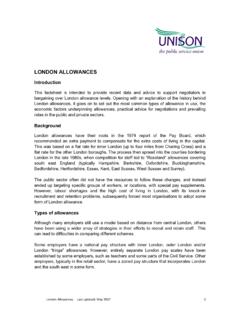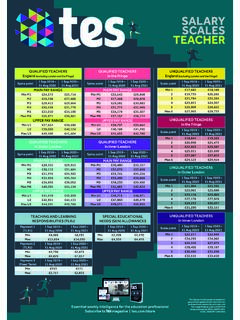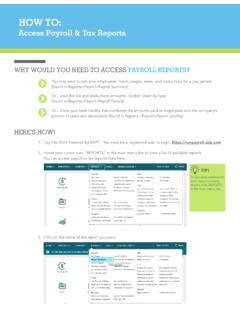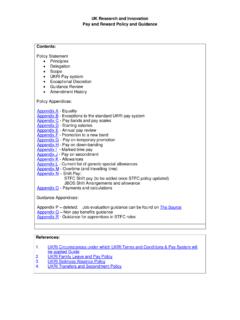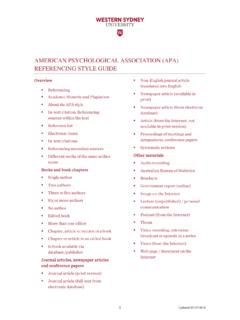Transcription of NEGOTIATING PAY STRUCTURES GUIDE - UNISON National
1 NEGOTIATING pay STRUCTURES GUIDE Last updated: October 2016 1 NEGOTIATING PAY STRUCTURES GUIDE Introduction This GUIDE will review the different types of pay systems being used across all UNISON s bargaining groups and provides advice to branches on how to make them work best for you. What is a pay structure ? A pay structure is a framework of pay grades in which employers implement pay for their employees.
2 Employers use different types of pay STRUCTURES in order to manage pay increases and career progression and they also use pay STRUCTURES to ensure that staff are paid fairly and equitably in a way which does not discriminate ( gender discrimination in pay). Levels of pay and how pay is distributed can have a massive impact on a business, including efficiency and productivity rates along with links to morale and motivation of the workforce. ACAS guidance states that pay systems should be clear, simple and easy to follow so that workers know and understand how much pay they are entitled to.
3 This might go some way to explain why more employers are now moving away from the more traditional hierarchical shape pay systems towards pay systems that incorporate fewer bands and job roles are more harmonised within their pay system. Different types of pay structure This factsheet describes some of the most commonly adopted pay STRUCTURES used by employers across the UNISON bargaining groups. The logic behind a pay structure is simple - it allows an employer to assign a pay rate or pay range to a job role.
4 They can use this pay system to support the organisation s strategic objectives ( they can reward high levels of performance) and they can adapt pay rates to job roles to mirror the local job market and they can offer pay progression through a pay range to reward long service or new skills that an employee has attained in the year. All pay systems have to comply with the law on equal pay. Women have the right to equal pay with men if they are doing like work or work that is of equal value.
5 For the purposes of this GUIDE pay systems have been defined by two types: A basic pay system where pay does not vary in relation to performance or length of employment. An incentivised system where pay is used in relation to results and performance and this includes the acquisition of skills NEGOTIATING pay STRUCTURES GUIDE Last updated: October 2016 2 UNISON branches can become involved in the negotiations around the selection of an employer s pay system in conjunction with a job evaluation process.
6 ACAS guidance sets out advice around selecting and installing a pay system, they also identify that it is good practise for employers to involve the recognised trade unions in this process and that it is helpful to form a joint working party. Further advice and links to more in-depth guidance on job evaluation can be found later in this GUIDE . Spot rates / individual pay rates This is the most basic method of payment, used by around a fifth of employers across the economy. Under this pay system employees are paid a single hourly / weekly / annual rate of pay.
7 UNISON has seen an increase in spot salary jobs within the Community and Voluntary Sector (CVS) in recent years. These types of pay structure are often attached to a job and are mainly found in lower-skilled occupations and at the other end of the scale in senior positions and management jobs. The biggest drawback of using spot rates to employ staff is that it leaves no scope for progression which can lead to problems with morale in the workplace and productivity issues.
8 Branches dealing with employers that are paying spot rates need to be aware that some employers are leaving themselves open to equal pay claims, especially if wage drift is allowed to happen. This is where an employee (over time) asks for and receives a pay increase, which may result in a group of workers, performing the same job role on different salaries. A recent study by The Institute of Fiscal Studies identified that women, on average, earn 18% less than men mainly because of the time women take out of work to have a family.
9 The study also highlighted that women on spot rates were more likely to earn 18% less an hour than their male counterparts. It is important that UNISON branches are up to date with new legislation on gender pay gap reporting and equal pay claims, as this is likely to become an issue in employers that use spot rates over the coming months. Spot salaries are often based on market-based pay which links salary levels to those rates available in the market. Regardless of the performance of the worker it is difficult for employees to progress as they are deemed to be earning market rate for their job.
10 UNISON s Bargaining Support has access to benchmarking data showing market rate salaries for different job roles across the economy. If your branch would like further information email bargaining support at Individual pay ranges This is a similar pay arrangement to spot rates, but instead of having a single rate for the job employees are employed on individual pay ranges . This allows for some form of pay progression. If branches are NEGOTIATING pay systems linked to spot rate salaries, clearly guiding an employer towards implementing an individual pay range is more advantageous than keeping staff on spot rates.




